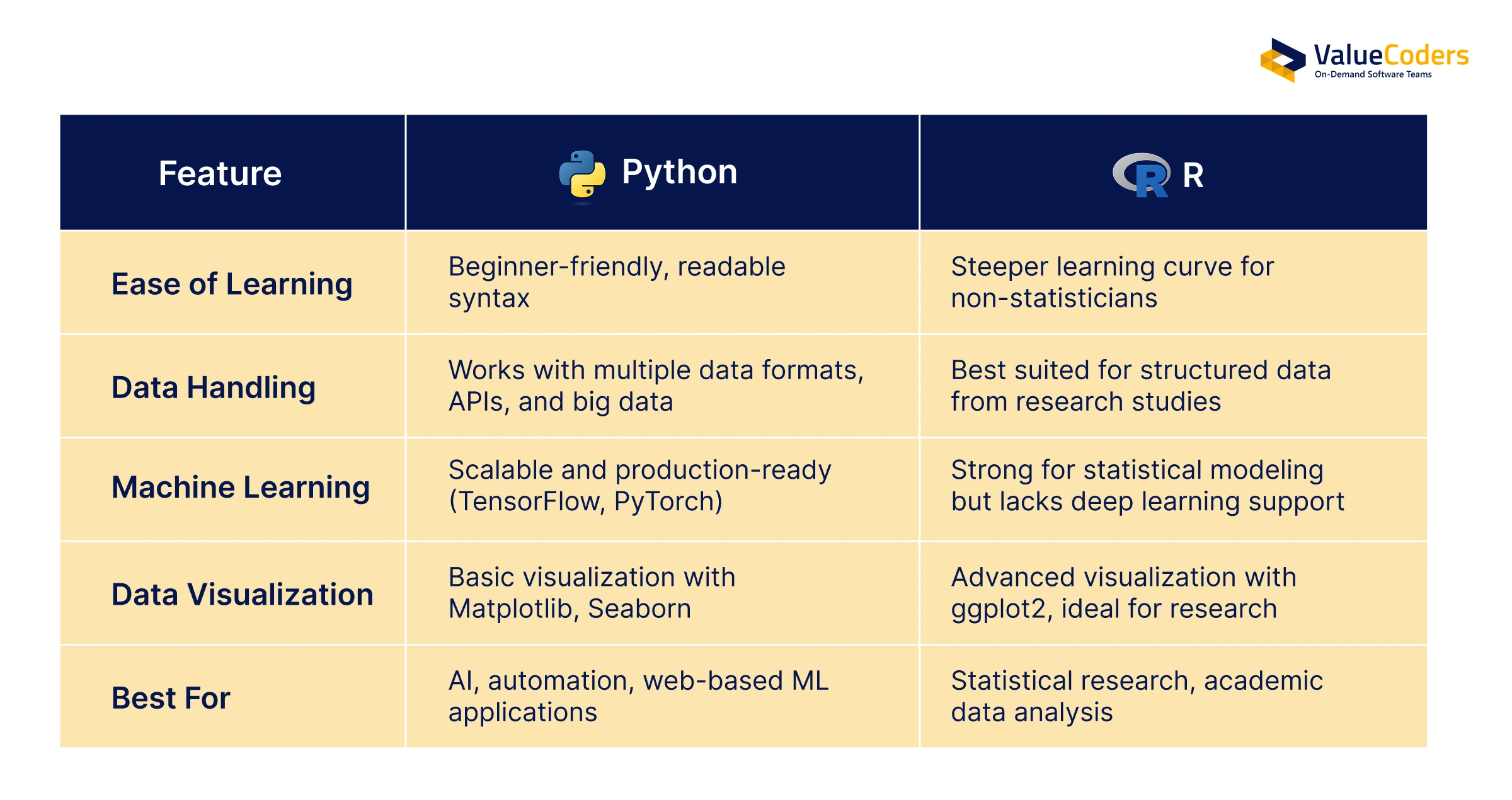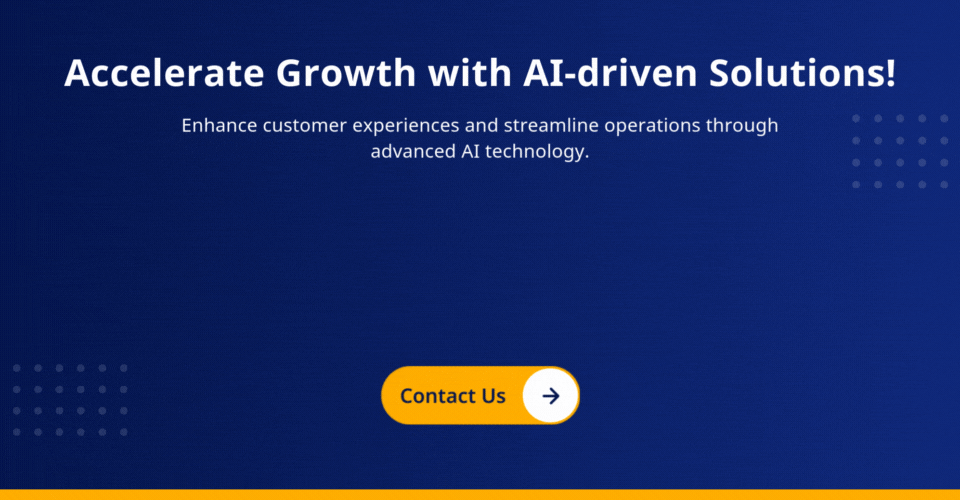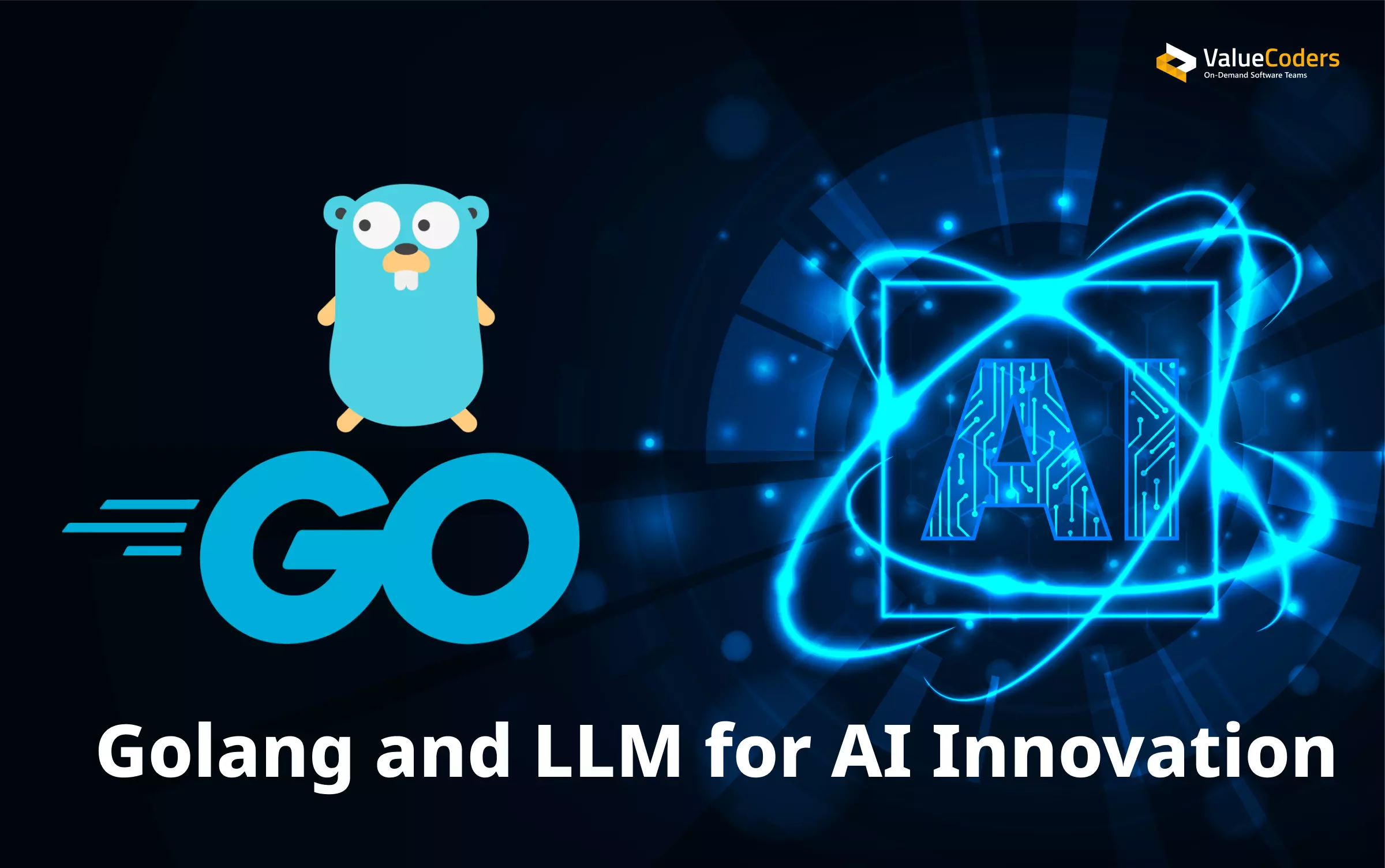Struggling to choose between R and Python for your next machine-learning project?
The two programming languages are popular in data science, predictive analytics, and automation, but serve different purposes.
R’s areas of strength are statistical computing and data analysis. Python, on the other hand, is more flexible for machine learning. The debate over R vs. Python for machine learning comes down to your goals, industry, and expertise. Here’s how they compare for data science and machine learning.
What is R Programming Language?

R is a free, open-source programming language for statistical computing and graphics. It helps analyze data, create visual reports, and build machine learning models. Widely used in research and business, R makes complex data easy to understand with its powerful tools and libraries.
Key Features of R:
- Tools for descriptive statistics, regression, multivariate analysis, and more.
- Thousands of packages like ggplot2 and caret for specialized tasks.
- High-quality graphics with libraries like ggplot2.
- Compatible with Windows, macOS, and Linux.
What is Python Programming Language?

Python supports multi-paradigm programming and is widely used for development solutions. For startups and enterprises, it is a reliable solution; look for Python development services to create a flexible, scalable, and robust solution.
Key Features of Python:
- Executes code line-by-line for quick debugging.
- English-like structure makes it accessible for beginners.
- Variables are determined at runtime, speeding up development.
- Object-oriented and functional programming styles.
- Allow extensive tools for data science and machine learning development.
Python is the go-to language for scalable AI solutions. Let our Python developers build your next big idea.
R vs Python: Which is Better for Machine Learning?

The key difference between R and Python for machine learning lies in their approach to data science. While both are open-source and widely supported, they serve different use cases.
Core Focus
Python: A versatile, easy-to-learn language widely used for data wrangling, machine learning, and scalable applications.
- Ideal for building ML models and AI automation applications.
- Used for face recognition API systems.
R: Designed for statistical computing and advanced data visualization, making it a top choice for analysts and researchers.
- Best suited for deep statistical analysis.
- Requires minimal coding from large datasets.
Data Collection
Python: Handles diverse data formats like CSV, JSON, and SQL tables. The requests library makes web scraping seamless for building datasets.
- Great at pulling information from websites and apps.
- Handles massive datasets without breaking a sweat.
- Perfect for working with messy, real-world data.
R: Primarily imports Excel, CSV, and text files. While it supports SPSS or Minitab formats, tools like Rvest enable basic web scraping, though Python remains more versatile.
- Works best with clean, organized data files.
- Excellent for traditional research data.
- It can grab web data, but not as smoothly as Python.
- Ideal for smaller, well-structured datasets.
Data Exploration
Python: Uses Pandas for fast data manipulation—filtering, sorting, and displaying data in seconds.
- Uses simple tools to sort and filter data quickly.
- Great at crunching numbers fast.
- Handles text, images, and numbers equally well.
- Perfect for cleaning up messy data.
R: Optimized for statistical exploration, offering probability distributions, hypothesis testing, and advanced data mining techniques.
- Built-in tools for deep statistical analysis.
- Makes it easy to spot patterns and outliers.
- Great for time-based data analysis.
- Better at explaining why numbers look the way they do.
Also read: Does Your Business Need A Data Engineer Or Data Scientist?
Data Modeling
Python: Leverages libraries like NumPy (numerical analysis), SciPy (scientific computing), and sci-kit-learn (machine learning) for robust modeling.
- Popular tools for creating predictive models.
- Great for building systems that learn from examples.
- Perfect for putting models into real-world use.
- Widely used in companies for automated systems.
R: Relies on core packages and the Tidyverse suite for streamlined data workflows, though some advanced modeling may require external packages.
- Strong statistical modeling capabilities.
- Perfect for research and testing theories.
- Great for exploring different analysis approaches.
- More common in academic and research settings.
Data Visualization
Python: Not just a strongest suit, but Matplotlib creates basic graphs, while Seaborn enhances visuals with attractive, informative charts.
- Makes basic charts and graphs easily.
- Can create interactive visualizations.
- Good for building data dashboards.
- Works well for web-based graphics.
R: Base graphics generate quick plots and ggplot2 crafts advanced visualizations like scatter plots with regression lines.
- Creates beautiful, publication-ready charts.
- Highly customizable graphics.
- Makes statistical plots look professional.
- Great for creating interactive data tools.
Python’s strength lies in versatility and scalability, making it ideal for large applications. R dominates in statistical analysis and stunning visualizations. Your choice depends on your goals: Choose a dedicated R or Python developer for deep statistical dives or general-purpose tasks, respectively.
Both are powerful for machine learning but require skilled developers. We help you hire AI experts who maximize their potential.
Advantages and Disadvantages of R vs. Python
R and Python each have unique strengths when it comes to data science. From R’s statistical precision to Python’s versatility. However, they also come with limitations; read the comparison below and choose the right tool.
Advantages of R Programming and Python Programming
| R Programming | Python Programming |
| It can be customized for statistical analysis and large datasets. | Versatile, a general-purpose language suitable for data science, AI, and web development. |
| Rich ecosystem of specialized packages like Tidyverse, ggplot2, and caret. | Extensive machine learning libraries like Pandas, Scikit-learn, and TensorFlow. |
| Powerful visualization tools like ggplot2 for publication-quality graphics. | Beginner-friendly syntax with English-like structure, making it easy to learn. |
| Preferred by scholars, researchers, and R&D teams for statistical modeling. | Strong community support with regular updates and abundant learning resources. |
| Integrated Development Environment (IDE) like RStudio for seamless workflows. | Integrates with modern tools like Jupyter Notebook, Spyder and Conda Enviro. |
Disadvantages of R Programming vs. Python Programming
| R Programming | Python Programming |
| Steeper learning curve, especially for beginners without a stats background. | Fewer specialized libraries for advanced statistical analysis compared to R. |
| Slower performance for computationally intensive tasks and large-scale processing. | Visualization libraries like Matplotib and Seabornlack polish compare to R’s ggplot2. |
| Inefficient memory management, leading to potential performance bottlenecks. | Less focused on academic research, catering more to developers and engineers. |
| Limited versatility; not ideal for tasks outside data science or statistics. | Dynamic typing can lead to runtime errors that might be caught earlier in static languages. |
| A smaller user base compared to Python, resulting in fewer third-party integrations. | The general-purpose nature may lack the depth of statistical tools found in R. |
R and Python each have strengths. Our AI experts help you choose and implement the best one for your business needs.
R and Python Usages in Data Science
Python and R in data science are the most commonly used languages to identify, represent, and extract meaningful information from data collected. Its core features include:
- Gathering relevant data from various sources.
- Analyzing and understanding data sets.
- Creating models to represent real-world processes.
- Presenting data in graphical formats for better interpretation.
- Applying statistical methods to analyze data.
Also read: Top 21 Machine Learning Development Companies Supporting SME & Enterprises ML Adoption
Choosing Between R and Python for Machine Learning
The choice between R vs. Python for machine learning is a big debate. The decision depends on your project needs, industry requirements, and technical expertise.
For advanced statistical modeling, hiring remote R developers can help you leverage R’s powerful analytics and visualization capabilities. Moreover, Python is the industry standard for machine learning, AI, and scalable applications, offering flexibility and robust libraries for automation and deep learning.
If you’re ready to start your machine learning project, our team of 50+ expert ML developers can help you. We already have helped 2,000+ businesses leverage the power of R and Python to implement machine learning models using cutting-edge tools and frameworks. Contact us to make the right choice.






